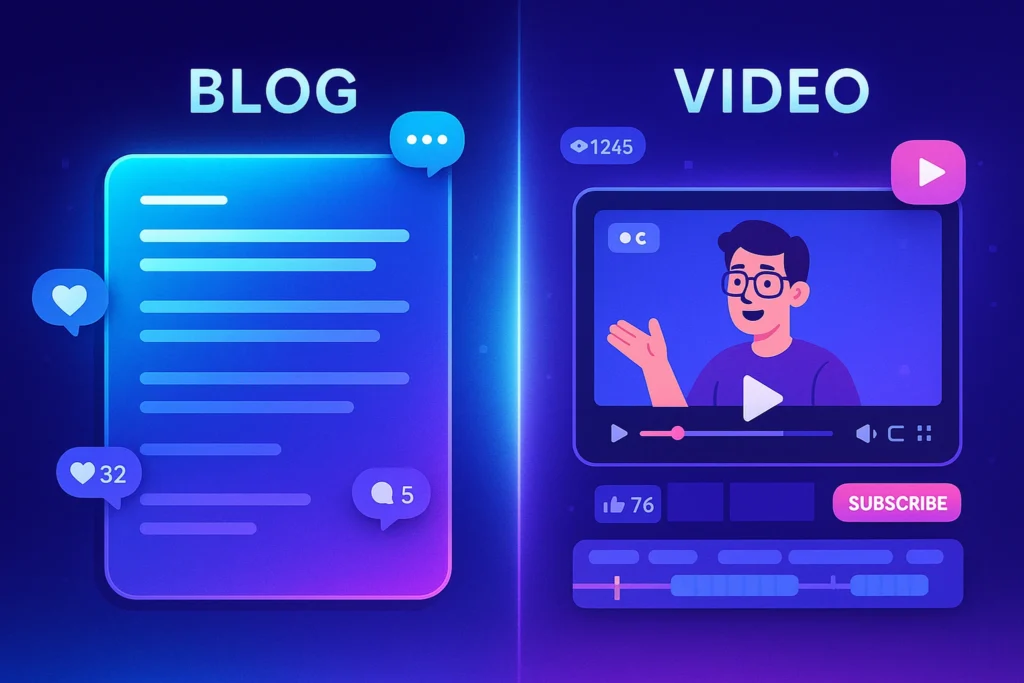-This post may contain affiliate links. If you click on one and make a purchase, I may earn a small commission at no extra cost to you.-
🎬 Introduction: Content Is King, But Format Is Queen
You’re ready to create content for your business—but you face a crucial question:
Should you focus on blog posts or videos?
Both are powerful. Both can drive traffic, build authority, and generate leads. But they work very differently depending on your audience, goals, and resources.
In this guide, we’ll break down the pros and cons of each format, explore key decision factors, and help you make an informed choice—or better yet, design a hybrid strategy that fits your business.
1. Audience Reach: Where Do Your People Hang Out?
Audience reach isn’t just about numbers—it’s about behavior and context. For example, Gen Z may discover you through short-form video on TikTok, but that doesn’t mean they won’t read a blog if it solves their exact pain point. Similarly, C-suite professionals might prefer well-researched articles, yet still appreciate a quick video overview to save time.
Also consider search intent. Informational queries (“how to fix X”) often favor blogs. Discovery-mode browsing (“best productivity hacks”) thrives in video-first platforms. Your job is to match format to audience intention and environment.
Before you create anything, ask: Where is your target audience already consuming content?
-
Blogs tend to perform well with audiences who prefer depth, research, and text-based learning. Think: B2B buyers, SEO traffic, newsletter readers.
-
Videos work best with visual learners, mobile users, and younger demographics. They’re ideal for quick consumption, product demos, and brand storytelling.
Quick Comparison:
| Metric | Blogging | Video |
|---|---|---|
| Best for | SEO-driven searchers | Social media + YouTube users |
| Session type | Deep reading, saved resources | Passive scroll, active viewing |
| Discovery | Google, newsletters | YouTube, Instagram, TikTok |
2. Engagement: Depth vs. Emotion
True engagement is more than views or scrolls—it’s emotional connection plus action. Blog readers engage through annotations, highlighting, and revisits. They’re more likely to take quiet, high-intent actions (click a link, sign up, bookmark).
Video viewers engage through comments, reactions, and shares. They process tone, body language, and editing pace, which can spark faster affinity.
If you’re building community or personal brand visibility, video may win. But if you’re focused on authority and trust, especially in niches like SaaS, finance, or education, blog engagement runs deeper.
Engagement is where these two formats begin to diverge.
-
Blogging offers room for nuance. It allows for long-form storytelling, internal linking, and structured arguments. Readers can skim, search, and return later.
-
Video taps into human emotion through tone, visuals, and music. It’s excellent for capturing attention fast—but it needs to earn retention.
Why this matters:
If your goal is to build trust, a blog post can act as a deep-dive resource center. But if you’re looking to spark emotion or show personality, video wins.
For maximum impact, use both: embed a short explainer video inside a blog post to increase dwell time and provide multiple entry points for your audience.
3. Cost & Production: Which Is More Resource-Intensive?
Beyond initial production, consider maintenance cost. A blog might require SEO updates every 6–12 months. A video may need re-editing if your branding changes, or re-shoots if stats become outdated.
Also factor in scalability. Blogging can scale with help from freelancers, AI writing tools, and editorial SOPs. Video often demands more specialized labor—camera ops, editors, thumbnail designers, etc.
That said, video tools like CapCut, Descript, and AI editing platforms are closing the gap. If you’re solo or lean, it’s now more possible than ever to produce good video without a studio setup.
At first glance, blogging seems cheaper—and it often is.
-
Blogging costs involve research, writing, editing, and SEO optimization. You might hire a writer or do it yourself.
-
Video requires scripting, filming, lighting, editing, thumbnails, and platform optimization. Not to mention gear (camera, mic) and software.
But here’s the nuance:
Video content can often be repurposed more widely—into shorts, blog transcriptions, podcasts, and social snippets.
✅ A high-quality blog post can last years in SERPs.
✅ A well-made video can get shared hundreds of times in a week.
So while video is more expensive upfront, it may bring faster, broader visibility.
Want to go deeper into repurposing? Our guide on Repurposing Content shows how one asset can be turned into five—especially if it starts as video.
4. SEO: Who Wins the Google Game?
Don’t underestimate hybrid content. Embedding short, optimized videos inside blog posts can improve time on page, lower bounce rate, and increase content richness—key signals Google loves.
Also, consider SERP diversity. Google now displays:
-
Text snippets (from blog posts)
-
Video carousels (from YouTube)
-
Featured snippets (blogs with schema)
-
Rich results (video timestamps)
So the best play isn’t choosing between SEO for blog or video—it’s using both to dominate search real estate across formats.
Blogging still reigns supreme in traditional SEO.
Google indexes written content more effectively than video. A well-optimized blog post can rank for dozens of keywords, attract backlinks, and build topical authority over time.
However, YouTube (owned by Google) is the second largest search engine in the world.
-
Video titles, descriptions, and timestamps now appear in search results.
-
Google is starting to pull clips and transcriptions into “video-rich” results.
So while a blog gives you more keyword control, video offers search visibility in multiple ecosystems—especially if you’re using transcripts, captions, and proper metadata.
Want to make blogging easier and more SEO-smart? Start with our ChatGPT Blog Writing Guide to build optimized articles faster.
5. Conversion & Funnel Fit: Where Do People Take Action?
Conversions don’t happen in a vacuum—they’re influenced by format psychology.
Video is great for emotional micro-conversions—liking a page, commenting, sharing. It builds momentum.
Blogging excels at macro-conversions—form fills, demo bookings, email signups—because it gives room for persuasion, context, and linking to next steps.
Also consider the product type:
-
A visual product (like fashion or software UI) needs demo video.
-
A technical product (like an API or course) needs blog explanation.
In high-ticket B2B, the winning move is often: video introduces, blog closes.
Which format converts better? It depends on the stage of the buyer journey.
-
Top of funnel: Video grabs attention on social and builds awareness.
-
Middle of funnel: Blogs educate, compare, and guide decisions.
-
Bottom of funnel: Case studies and testimonials (in either format) close the deal.
Use blogging to nurture leads with depth and internal linking. Use video to build trust with tone, face, and story.
💡 Combine the two: Film a “video FAQ” based on your blog’s comments section. Embed it in your lead-nurturing emails. That’s multi-format synergy.
6. Longevity & Shelf Life: Which Format Has Staying Power?
Blog posts, if updated and optimized, become SEO assets—like digital real estate. They age well, and Google rewards historical content that evolves with search behavior.
Videos, however, benefit from algorithm momentum. YouTube may surface a video you posted months ago—especially if it gets watch time and engagement.
To maximize shelf life:
-
Create evergreen content in both formats.
-
Avoid time-sensitive titles (“Best X Tools in July”) unless you plan to refresh.
-
Add dates to blog posts—but not to video titles (unless timely).
Longevity isn’t about format alone—it’s about topic selection and content upkeep.
Blogs are timeless—when written well.
A strong blog can live for 3+ years, consistently bringing in organic traffic with periodic updates.
Videos often have a shorter half-life unless they’re evergreen tutorials or ranking on YouTube. But on platforms like Instagram or TikTok, the shelf life may be just days.
That said, short-form video offers speed and volume, which can snowball visibility faster than any post on Google.
The solution? Use blog content as a foundation and feed your short-form video pipeline. Learn how in our full Repurposing Content strategy guide.
7. Learning Curve & Tools Required
Each format has its own learning plateau.
-
Blogging requires understanding of voice, structure, formatting, keyword research, and publishing systems.
-
Video demands comfort with presence, rhythm, lighting, sound, editing, and scripting—though not all at once.
But don’t let either intimidate you. You can start:
-
Blogging with Notion + Grammarly + WordPress
-
Video with smartphone + CapCut + Canva for thumbnails
The key is not mastering the tools overnight—but building repeatable workflows that grow with your skills.
Blogging requires:
-
Writing clarity
-
Basic SEO knowledge
-
CMS usage (like WordPress)
Video requires:
-
On-camera comfort (or editing skills)
-
Lighting/audio equipment
-
Platform-specific optimizations (YouTube, Reels, Shorts)
If you’re just starting, blogging is easier to launch. But tools like Descript, CapCut, and Canva make video creation more accessible than ever. Our list of Content Creation Tools includes what you need to get started with both formats.
✅ Format Snapshot: Quick Comparison Table
| Factor | Blogging | Video |
|---|---|---|
| Cost | Lower upfront | Higher production + tools |
| SEO Power | High (Google search) | Medium (YouTube + rich snippets) |
| Engagement Style | Analytical, long-form | Emotional, dynamic |
| Repurposability | Medium (into socials/emails) | High (into blog/audio/snippets) |
| Funnel Role | Educate + Convert (Mid-Late) | Attract + Trust-Build (Top-Mid) |
| Shelf Life | Long (evergreen content) | Shorter (unless SEO-ranked) |
| Tools Needed | WordPress, Grammarly, Surfer SEO | Camera, mic, editing, scripting |
🎯 Choosing Your Primary Format
Here’s a quick decision tree to guide your format focus:
-
Are you camera-shy or resource-limited? → Start with blogging
-
Is your brand personality-driven or highly visual? → Lean into video
-
Is organic traffic a key growth lever? → Double down on blogs for SEO
-
Do you sell low-friction, impulse-friendly products? → Short-form video converts faster
-
Want long-term authority and top-of-funnel reach? → Combine both
Also, consider your energy alignment. If writing energizes you, don’t force yourself into weekly videos. If talking is your strength, use voice-first video and transcribe into blog content.
Your best content format is the one you’ll consistently execute—not just theoretically “optimize.”
Still unsure?
Here’s a quick guide:
-
Start with blogging if you want organic SEO traffic, enjoy writing, or have limited resources.
-
Start with video if you’re a strong speaker, need fast engagement, or want to build personal brand trust.
The best content strategies don’t choose—they layer. Blog + video = visibility + depth.
🧪 Real-World Use Case: The Hybrid Growth Model
Case: A SaaS startup in the productivity niche.
They began with weekly blog posts targeting SEO keywords (“best project management tools,” “remote team tips”). Traffic grew, but conversions stalled.
Then, they added short videos to each blog post:
-
1-minute summaries for YouTube Shorts
-
Tutorial walk-throughs embedded in blog posts
-
Social teasers on LinkedIn and Instagram
Result:
-
Time on site doubled
-
YouTube became the #2 referral source
-
Email opt-ins increased by 40%
-
Blog traffic didn’t just grow—it converted
🧠 Nerd Verdict
Choosing between video and blogging isn’t about picking a winner.
It’s about aligning format with function.
Blogging gives you search power, structure, and scalability.
Video gives you emotion, speed, and visibility.
But the smartest marketers combine them—turning blogs into videos, and videos into blog embeds. It’s not video versus blogging. It’s video-powered blogging.
Start where you’re strongest. Then expand where your audience responds.
❓ FAQ: Nerds Ask, We Answer
💬 Would You Bite?
What’s your core format right now—blog, video, or both?
Let us know below. Your answer might inspire our next creator strategy breakdown. 👇



